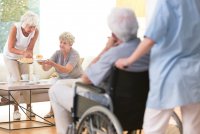|
What you say and how you say it will have a tremendous impact on your success as a care provider. The spoken word has the power to heal and equally so, the power to hurt. Words guide, motivate and influence others. They convey our thoughts and all too easily can dramatically change the outcome of even the most well intentioned actions. Words can enlighten, uplift and bestow a sense of mutual understanding and lastly, particularly in healthcare, a spoken word is one of the singularly most potent treatments that will enable healthcare professionals to establish a trusting relationship with those they serve.
One critical skill that should become you're standard daily practice is to introduce yourself each and every time during your interaction with your resident. You will be doing it many times throughout your workday, especially in the first few weeks of a resident's admission to the facility. Introduce yourself with a smile while pointing to your name badge to help residents remember your name until they become familiar with you.
-
Address the resident by Mr./Mrs. and their last name. Residents who want you to use their first names will very quickly tell you what name they prefer; whether name or nickname.
-
Never, never use terms like "sweetie" or "dear." A fair number of healthcare providers do this in an absent minded way not meaning to cause offense. It is often an unconscious pattern of speech that is, however, both undignified and unprofessional.
|


Recommended Comments
There are no comments to display.
Join the conversation
You can post now and register later. If you have an account, sign in now to post with your account.